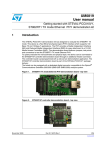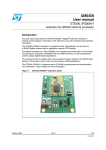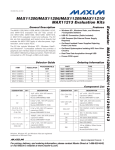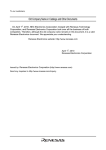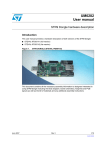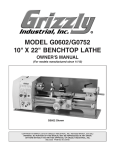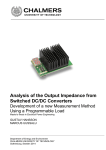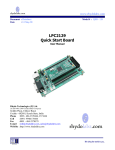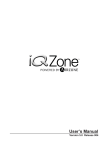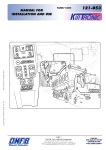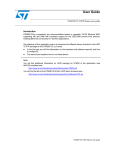Download Getting started with STEVAL-PCC010V1, ST802RT1 TX mode
Transcript
UM0819 User manual Getting started with STEVAL-PCC010V1, ST802RT1 TX mode Ethernet PHY demonstration kit 1 Introduction The STEVAL-PCC010V1 demonstration kit was designed to evaluate the ST802RT1 TX mode. This device is a Fast Ethernet physical layer (PHY) interface which supports 100 Base-TX and 10 Base-T applications. The PHY provides a Media Independent Interface (MII) and Reduced Media Independent Interface (RMII) for easy attachment to a 10/100 Media Access Controllers (MAC). The demonstration board features jumpers, test points and connectors to test the ST802RT1 TX mode Ethernet PHY. To quickly evaluate the microcontroller and physical layer, the device can be connected to the STM32F107 controller demonstration board through an additional header connector. The controller board is preprogrammed with a web server demonstration application. The STM32F107 controller demonstration board is part of the STEVAL-PCC010V1 package delivery. The board can be equipped with a dedicated digital connector compatible to the Spirent® Communications SmartBits 200/2000 (SMB-200/ SMB-2000) analysis system. May 2010 Figure 1. ST802RT1 TX mode Ethernet PHY demonstration board - top view Figure 2. STM32F107 controller demonstration board - top view Doc ID 16379 Rev 2 1/37 www.st.com UM0819 Contents Contents 1 Introduction . . . . . . . . . . . . . . . . . . . . . . . . . . . . . . . . . . . . . . . . . . . . . . . . 1 2 Boards key features . . . . . . . . . . . . . . . . . . . . . . . . . . . . . . . . . . . . . . . . . 6 2.1 ST802RT1 TX mode Ethernet PHY demonstration board . . . . . . . . . . . . . 6 2.2 STM32F107 controller demonstration board . . . . . . . . . . . . . . . . . . . . . . . 6 3 General system description . . . . . . . . . . . . . . . . . . . . . . . . . . . . . . . . . . . 7 4 Getting started . . . . . . . . . . . . . . . . . . . . . . . . . . . . . . . . . . . . . . . . . . . . . . 8 5 6 4.1 Package contents . . . . . . . . . . . . . . . . . . . . . . . . . . . . . . . . . . . . . . . . . . . . 8 4.2 How to run the demonstration software . . . . . . . . . . . . . . . . . . . . . . . . . . . 8 Boards layout . . . . . . . . . . . . . . . . . . . . . . . . . . . . . . . . . . . . . . . . . . . . . . 13 5.1 Board layout - ST802RT1 TX mode Ethernet PHY demonstration board . . . . . . . . . . . . . . . . . . . . . . . . . . . . . . . . . . . . . . . . . . . . . . . . . . . . 13 5.2 Board layout - STM32F107 controller demonstration board . . . . . . . . . . . 14 Configuration and functionality . . . . . . . . . . . . . . . . . . . . . . . . . . . . . . . 15 6.1 6.2 7 Configuration and functionality- ST802RT1 TX mode Ethernet PHY . . . . . . demonstration board . . . . . . . . . . . . . . . . . . . . . . . . . . . . . . . . . . . . . . . . 15 6.1.1 Boot strap options . . . . . . . . . . . . . . . . . . . . . . . . . . . . . . . . . . . . . . . . . 15 6.1.2 Solder bridges . . . . . . . . . . . . . . . . . . . . . . . . . . . . . . . . . . . . . . . . . . . . 17 6.1.3 RESET button . . . . . . . . . . . . . . . . . . . . . . . . . . . . . . . . . . . . . . . . . . . . 17 6.1.4 LEDs . . . . . . . . . . . . . . . . . . . . . . . . . . . . . . . . . . . . . . . . . . . . . . . . . . . 17 6.1.5 Test point MCO . . . . . . . . . . . . . . . . . . . . . . . . . . . . . . . . . . . . . . . . . . . 18 Configuration and functionality - STM32F107 controller demonstration board . . . . . . . . . . . . . . . . . . . . . . . . . . . . . . . . . . . . . . . . . . . . . . . . . . . . 18 6.2.1 MII/RMII configuration . . . . . . . . . . . . . . . . . . . . . . . . . . . . . . . . . . . . . . 18 6.2.2 Buttons . . . . . . . . . . . . . . . . . . . . . . . . . . . . . . . . . . . . . . . . . . . . . . . . . . 19 6.2.3 LEDs . . . . . . . . . . . . . . . . . . . . . . . . . . . . . . . . . . . . . . . . . . . . . . . . . . . 19 6.2.4 Test point MCO . . . . . . . . . . . . . . . . . . . . . . . . . . . . . . . . . . . . . . . . . . . 19 Connectors . . . . . . . . . . . . . . . . . . . . . . . . . . . . . . . . . . . . . . . . . . . . . . . 20 7.1 Connectors of the ST802RT1 TX mode Ethernet PHY demonstration board . . . . . . . . . . . . . . . . . . . . . . . . . . . . . . . . . . . . . . . . . . . . . . . . . . . . 20 Doc ID 16379 Rev 2 2/37 Contents UM0819 7.2 8 7.1.1 MII/RMII debugging connector J1 . . . . . . . . . . . . . . . . . . . . . . . . . . . . . 20 7.1.2 MII/RMII connector P1 . . . . . . . . . . . . . . . . . . . . . . . . . . . . . . . . . . . . . . 21 7.1.3 RJ45 connector J9 . . . . . . . . . . . . . . . . . . . . . . . . . . . . . . . . . . . . . . . . . 21 Connectors of the STM32F107 controller board . . . . . . . . . . . . . . . . . . . 22 7.2.1 USB connector CN1 . . . . . . . . . . . . . . . . . . . . . . . . . . . . . . . . . . . . . . . 22 7.2.2 JTAG connector CN2 . . . . . . . . . . . . . . . . . . . . . . . . . . . . . . . . . . . . . . . 22 7.2.3 MII/RMII connector CN3 . . . . . . . . . . . . . . . . . . . . . . . . . . . . . . . . . . . . 23 7.2.4 GPIO connector CN4 . . . . . . . . . . . . . . . . . . . . . . . . . . . . . . . . . . . . . . . 24 List of transformers and RJ45 connectors with embedded transformers with turn ratio 1.414:1 . . . . . . . . . . . . . . . . . . . . . . . . . . . 25 Appendix A ST802RT1 TX mode Ethernet PHY demonstration board - BOM . . . . . . . . . . . . . . . . . . . . . . . . . . . . . . . . . . . . . . . . . . . . . . . . . 26 Appendix B STM32F107 controller demonstration board - BOM . . . . . . . . . . . . 28 Appendix C ST802RT1 TX mode Ethernet PHY demonstration board - schematic . . . . . . . . . . . . . . . . . . . . . . . . . . . . . . . . . . . . . . . . . . . . . 30 Appendix D STM32F107 controller demonstration board - schematic . . . . . . . 34 Revision history . . . . . . . . . . . . . . . . . . . . . . . . . . . . . . . . . . . . . . . . . . . . . . . . . . . . 36 3/37 Doc ID 16379 Rev 2 UM0819 List of tables List of tables Table 1. Table 2. Table 3. Table 4. Table 5. Table 6. Table 7. Table 8. Table 9. Table 10. Table 11. Table 12. Table 13. Table 14. Table 15. Table 16. Table 17. Table 18. Table 19. Auto-negotiation jumper settings . . . . . . . . . . . . . . . . . . . . . . . . . . . . . . . . . . . . . . . . . . . . 16 PHY MII address jumper settings . . . . . . . . . . . . . . . . . . . . . . . . . . . . . . . . . . . . . . . . . . . . 16 Power-down jumper settings . . . . . . . . . . . . . . . . . . . . . . . . . . . . . . . . . . . . . . . . . . . . . . . 16 Loopback jumper setting. . . . . . . . . . . . . . . . . . . . . . . . . . . . . . . . . . . . . . . . . . . . . . . . . . . 17 MII/RMII jumper settings . . . . . . . . . . . . . . . . . . . . . . . . . . . . . . . . . . . . . . . . . . . . . . . . . . . 17 MII/RMII interface selection . . . . . . . . . . . . . . . . . . . . . . . . . . . . . . . . . . . . . . . . . . . . . . . . 17 LEDs functionality - alternative 1 . . . . . . . . . . . . . . . . . . . . . . . . . . . . . . . . . . . . . . . . . . . . 17 LEDs functionality - alternative 2 . . . . . . . . . . . . . . . . . . . . . . . . . . . . . . . . . . . . . . . . . . . . 18 MII/RMII interface selection by solder bridges SB1, SB2 and SB3. . . . . . . . . . . . . . . . . . . 18 MII/RMII debugging connector J1 . . . . . . . . . . . . . . . . . . . . . . . . . . . . . . . . . . . . . . . . . . . . 20 MII/RMII connector P1 . . . . . . . . . . . . . . . . . . . . . . . . . . . . . . . . . . . . . . . . . . . . . . . . . . . . 21 RJ45 connector J9 . . . . . . . . . . . . . . . . . . . . . . . . . . . . . . . . . . . . . . . . . . . . . . . . . . . . . . . 21 USB connector CN1 . . . . . . . . . . . . . . . . . . . . . . . . . . . . . . . . . . . . . . . . . . . . . . . . . . . . . . 22 JTAG connector CN2 . . . . . . . . . . . . . . . . . . . . . . . . . . . . . . . . . . . . . . . . . . . . . . . . . . . . . 23 MII/RMII connector CN3 . . . . . . . . . . . . . . . . . . . . . . . . . . . . . . . . . . . . . . . . . . . . . . . . . . . 24 GPIO connector CN4 . . . . . . . . . . . . . . . . . . . . . . . . . . . . . . . . . . . . . . . . . . . . . . . . . . . . . 24 Bill of material ST802RT1 TX mode . . . . . . . . . . . . . . . . . . . . . . . . . . . . . . . . . . . . . . . . . . 26 Bill of material STM32F107 . . . . . . . . . . . . . . . . . . . . . . . . . . . . . . . . . . . . . . . . . . . . . . . . 28 Document revision history . . . . . . . . . . . . . . . . . . . . . . . . . . . . . . . . . . . . . . . . . . . . . . . . . 36 Doc ID 16379 Rev 2 4/37 List of figures UM0819 List of figures Figure 1. Figure 2. Figure 3. Figure 4. Figure 5. Figure 6. Figure 7. Figure 8. Figure 9. Figure 10. Figure 11. Figure 12. Figure 13. Figure 14. Figure 15. Figure 16. Figure 17. Figure 18. Figure 19. Figure 20. Figure 21. Figure 22. Figure 23. Figure 24. 5/37 ST802RT1 TX mode Ethernet PHY demonstration board - top view . . . . . . . . . . . . . . . . . . 1 STM32F107 controller demonstration board - top view . . . . . . . . . . . . . . . . . . . . . . . . . . . . 1 ST802RT1 TX mode Ethernet PHY demonstration kit . . . . . . . . . . . . . . . . . . . . . . . . . . . . 7 ST802RT1 TX mode demonstration board connected to STM32F107 demonstration board. . . . . . . . . . . . . . . . . . . . . . . . . . . . . . . . . . . . . . . . . . . . . . . . . . . . . . . . . . . . . . . . . . . 9 Network connections dialog box . . . . . . . . . . . . . . . . . . . . . . . . . . . . . . . . . . . . . . . . . . . . . 10 Internet Protocol (TCP/IP) Properties dialog box . . . . . . . . . . . . . . . . . . . . . . . . . . . . . . . . 11 First page of the web server demonstration software . . . . . . . . . . . . . . . . . . . . . . . . . . . . . 12 Board layout - ST802RT1 TX mode Ethernet PHY demonstration board. . . . . . . . . . . . . . 13 Board layout - STM32F107 controller demonstration board . . . . . . . . . . . . . . . . . . . . . . . . 14 Jumper configuration . . . . . . . . . . . . . . . . . . . . . . . . . . . . . . . . . . . . . . . . . . . . . . . . . . . . . 15 MII/RMII debugging connector J1 . . . . . . . . . . . . . . . . . . . . . . . . . . . . . . . . . . . . . . . . . . . . 20 MII/RMII connector P1 . . . . . . . . . . . . . . . . . . . . . . . . . . . . . . . . . . . . . . . . . . . . . . . . . . . . 21 Ethernet RJ45 connector J9 - front view. . . . . . . . . . . . . . . . . . . . . . . . . . . . . . . . . . . . . . . 21 USB connector CN1 . . . . . . . . . . . . . . . . . . . . . . . . . . . . . . . . . . . . . . . . . . . . . . . . . . . . . . 22 JTAG connector CN2 . . . . . . . . . . . . . . . . . . . . . . . . . . . . . . . . . . . . . . . . . . . . . . . . . . . . . 22 JTAG connector CN2 - schematic . . . . . . . . . . . . . . . . . . . . . . . . . . . . . . . . . . . . . . . . . . . 23 MII/RMII connector CN3 . . . . . . . . . . . . . . . . . . . . . . . . . . . . . . . . . . . . . . . . . . . . . . . . . . . 23 GPIO connector CN4 . . . . . . . . . . . . . . . . . . . . . . . . . . . . . . . . . . . . . . . . . . . . . . . . . . . . . 24 ST802RT1 TX mode Ethernet PHY demonstration board - schematic - part 1 . . . . . . . . . 30 ST802RT1 TX mode Ethernet PHY demonstration board - schematic - part 2 . . . . . . . . . 31 ST802RT1 TX mode Ethernet PHY demonstration board - schematic - part 3 . . . . . . . . . 32 ST802RT1 TX mode Ethernet PHY demonstration board - schematic - part 4 . . . . . . . . . 33 STM32F107 controller demonstration board - schematic - part 1. . . . . . . . . . . . . . . . . . . . 34 STM32F107 controller demonstration board - schematic - part 2. . . . . . . . . . . . . . . . . . . . 35 Doc ID 16379 Rev 2 UM0819 Boards key features 2 Boards key features 2.1 ST802RT1 TX mode Ethernet PHY demonstration board 2.2 ● ST802RT1 TX mode Fast Ethernet physical layer transceiver ● On-board 3.3 V LDO regulator ● On-board 25 MHz crystal ● 12 jumpers for boot-strap configuration (MII address, auto-negotiation, loopback, power-down, MII/RMII configuration) ● Several GND test points and jumpers for power consumption measurement ● Connectors – 20-pin full pitch header connector for debug purposes (compatible to the STM32F107 controller board) – 40-pin connector compatible to the Spirent Communications SmartBits 200/2000 (SMB-200/ SMB-2000) analysis system (not assembled) – RJ45 connector with embedded transformer STM32F107 controller demonstration board ● STM32F107 connectivity line Cortex™-M3 based microcontroller with embedded Ethernet MAC ● On-board 3.3 V LDO regulator ● On-board 25 MHz crystal ● Reset button, power LED, general-purpose button and two LEDs ● Connectors – 20-pin full pitch header connector for debug purposes and compatibility to the ST802RT1 TX mode demonstration board – 20-pin JTAG connector – Additional general-purpose 20-pin full pitch header connector – USB device connector (+5 V power supply) Doc ID 16379 Rev 2 6/37 General system description 3 UM0819 General system description The STEVAL-PCC010V1 ST802RT1 TX mode Ethernet PHY demonstration kit consists of two boards. The ST802RT1 TX mode demonstration board was designed to evaluate the chip. It therefore allows to easily select the PHY boot options, to evaluate the PHY boot options, to evaluate the power consumption of the chip and to attach the device to the professional test equipment. In addition, the STM32F107 controller demonstration board can extend the ST802RT1 TX mode demonstration board with STM32™ microcontroller and its embedded MAC. This allows to quickly evaluate application on the embedded microcontroller and the Ethernet PHY. By default, the controller board is preprogrammed with a web-server application for demonstration purposes. Figure 3. ST802RT1 TX mode Ethernet PHY demonstration kit 34-& DEMONSTRATIONBOARD 34-& 342448MODE DEMONSTRATIONBOARD 3424 4RANSFORMER "ASE4 2* 41&0 "ASE48 !- Figure 3 shows the ST802RT1 TX mode Ethernet PHY demonstration kit. It consists of two boards: the ST802RT1 TX mode Ethernet PHY demonstration board, and the STM32F107 controller demonstration board connected through the MII/RMII connector. 7/37 Doc ID 16379 Rev 2 UM0819 4 Getting started Getting started This section briefly describes how to start using the STEVAL-PCC010V1 ST802RT1 TX mode Ethernet PHY demonstration kit. To use this demonstration kit you must install a web browser on your computer. 4.1 Package contents The ST802RT1 TX mode Ethernet PHY demonstration kit includes the following items: Hardware content ● One ST802RT1 TX mode Ethernet PHY demonstration board ● One STM32F107 controller demonstration board Software content ● Web server - demonstration software based on uIP TCP/IP stack Documentation 4.2 ● STM32F107xx datasheet, ST802RT1 product documentation ● This user manual How to run the demonstration software This section describes the demonstration software delivered with the ST802RT1 TX mode Ethernet PHY demonstration kit. The software implements a simple web server based on uIP TCP/IP stack. The web server consists of three pages displaying general information about the STM32 and ST802RT1 TX mode, allowing to control LEDs on the STM32F107 controller board and finally showing the content of the ST802RT1 TX mode registers. To run the demonstration software, you need a demonstration kit, an Ethernet cable, and a PC with a web browser. Follow the steps below: 1. Connect the boards delivered in the package as shown on the Figure 4. Doc ID 16379 Rev 2 8/37 Getting started UM0819 Figure 4. 2. Setup properly jumpers on the ST802RT1 TX mode Ethernet PHY demonstration board. The software does not change any settings of the PHY; it reads the settings from the PHY instead. See Section 6.1 for more details about board setup. 3. Connect ST802RT1 TX mode Ethernet PHY board to STM32F107 controller board. 4. Connect Ethernet cable to the ST802RT1 TX mode Ethernet PHY board on one side and to the PC on the other side. 5. Flash the demonstration software into the Flash memory of the STM32F107 MCU. 6. Configure your PC. The following description is valid for Windows® XP; nevertheless it is easy to setup any other operating system in a similar way. a) 9/37 ST802RT1 TX mode demonstration board connected to STM32F107 demonstration board Setup network settings: in Control Panel - Network Connections right click your network card and open Properties. Doc ID 16379 Rev 2 UM0819 Getting started Figure 5. b) Network connections dialog box Select IP protocol properties: select Internet Protocol (TCP/IP) and click Properties. Doc ID 16379 Rev 2 10/37 Getting started UM0819 Figure 6. c) Internet Protocol (TCP/IP) Properties dialog box Change you IP settings to: IP address: 192.168.0.4 Subnet mask: 255.255.255.0 d) 11/37 Disable firewall(s) running on your PC. Doc ID 16379 Rev 2 UM0819 Getting started 7. Figure 7. Run your web browser and open page http://192.168.0.8. You should be able to see the first page of the web server running on the demonstration kit. First page of the web server demonstration software 8. You can also ping to the board using ping command on your PC. Doc ID 16379 Rev 2 12/37 Boards layout UM0819 5 Boards layout 5.1 Board layout - ST802RT1 TX mode Ethernet PHY demonstration board Figure 8. 13/37 Board layout - ST802RT1 TX mode Ethernet PHY demonstration board Doc ID 16379 Rev 2 UM0819 5.2 Boards layout Board layout - STM32F107 controller demonstration board Figure 9. Board layout - STM32F107 controller demonstration board Doc ID 16379 Rev 2 14/37 Configuration and functionality 6 UM0819 Configuration and functionality This section describes the functions and configuration of STM802RT1A Ethernet PHY demonstration board and STM32F107 controller demonstration board. 6.1 Configuration and functionality- ST802RT1 TX mode Ethernet PHY demonstration board In this chapter jumper “high” means that the jumper is placed in the position closer to the top edge of the board and “low” means that the jumper is placed in the position closer to the bottom edge of the board as shown by Figure 10. Figure 10. Jumper configuration 6.1.1 Boot strap options The ST802RT1 TX mode PHY uses many of the functional pins as strap options. The values of these pins are sampled during hardware reset and power up. They are used to strap signals on the device into specific modes of operation. The ST802RT1 TX mode provides a simple strap option to automatically configure the device to operate in the modes requiring no device register configuration. All strap pins have a weak internal pull-ups or pull-downs. To change the default strap value, the strap pins should be connected directly to VCC or GND with an external 2.2 kΩ resistor. The software reset and power-down through the power-down pin cannot be used to change the strap configuration. Auto-negotiation Auto-negotiation is performed as part of the initial set-up of the link. It allows the PHYs connected to the cable to exchange their key features (speed, PHY type, half or full duplex) and automatically select the link communication mode. If auto-negotiation is disabled the chip stays at the speed that is selected by strap pins. If the partner PHY speed is the same, the link ON state is signaled otherwise no link state is signaled. 15/37 Doc ID 16379 Rev 2 UM0819 Configuration and functionality Table 1. Auto-negotiation jumper settings(1) Jumper Description Default configuration JP16 AN_1 High JP17 AN_0 High JP18 AN_EN - Auto-negotiation enable; when “high” - autonegotiation enabled, when “low” - auto-negotiation disabled High 1. See functionality of AN_xxx pins in the ST802RT1 product documentation. PHY MII address The MDIO/MDC serial management interface is used to access the internal registers of the PHY. The Ethernet MAC that is connected to the PHY must know the appropriate PHY address for successful communication. Special case is the PHY address 0x00. If this address is used as the bootstrap address during the reset, the 00000 value is latched into the internal receive mode control register RN14 (0x14h) but the PHY goes also to the isolation mode. It is possible to change the PHY address by writing the RN14 register later when application is already running. Table 2. PHY MII address jumper settings Jumper Description Default configuration JP11 MII address 0 High JP12 MII address 1 Low JP13 MII address 2 Low JP14 MII address 3 Low JP15 MII address 4 Low Power-down This pin is an active low input of the PHY and should be asserted low to put the device in a power-down mode. During the power-down mode, TXP/TXN outputs and all LED outputs are 3-stated, and the MII interface is isolated. The power-down functionality is also achievable by software by asserting bit 11 of register RN00. Table 3. Power-down jumper settings Jumper Description Default configuration JP1 Power-down, if fitted - PHY works normally; if not fitted - PHY is in power-down mode Fitted Loopback Local loopback passes data internally from the transmitting to the receiving serial analog logic. There are two ways to enter the internal loopback mode, either writing RN00 register, bit 14 (MDIO/MDC) or by using boot strap LPBK pin (VDD - enabled, GND - disabled, through 2.2 kΩ resistor). Doc ID 16379 Rev 2 16/37 Configuration and functionality Table 4. UM0819 Loopback jumper setting Jumper Description Default configuration JP8 LPBK - loopback; “high” - internal loopback selected (mainly for debug purposes); “low” - normal operation Low MII/RMII mode selection A strapping option allows setting the operating mode of the MAC data interface. Default operation (no pull-ups) enable normal MII mode of operation. Strapping CF0 high will cause the device to be in RMII. Table 5. Jumper Description Default configuration JP9 CF0 - MAC data interface selection Low JP10 CF1 - MAC data interface selection Low Table 6. 6.1.2 MII/RMII jumper settings MII/RMII interface selection CF0 (JP9) CF1 (JP10) MII Low X RMII High Low Solder bridges The SB1 and SB2 solder bridges are used to connect 25MHz crystal X1 to the ST802RT1 TX mode PHY. They can be removed to disconnect the crystal when external clock signal on test point MCO is used as the input clock. 6.1.3 RESET button The RESET button resets the ST802RT1 TX mode PHY to its initial state. 6.1.4 LEDs By default the LEDs have the following functionality: Table 7. 17/37 LEDs functionality - alternative 1 LED Description Details LED1 BLINK for activity JP16 is low LED2 BLINK for activity JP16 is high LED3 ON for 100 Mb / OFF for 10 Mb JP17 is low LED4 ON for 100 Mb / OFF for 10 Mb JP17 is high LED5 ON for link up / OFF for link down JP18 is low LED6 ON for link up / OFF for link down JP18 is high Doc ID 16379 Rev 2 UM0819 Configuration and functionality Alternatively it is possible to change the meaning of LED1 - LED6 by writing the PHY register RN1B [0d27, 0x1B]: Table 8. 6.1.5 LEDs functionality - alternative 2 LED Description Details LED1 ON for full duplex, BLINK for collision JP16 is low LED2 ON for full duplex, BLINK for collision JP16 is high LED3 ON for 100 Mb / OFF for 10 Mb JP17 is low LED4 ON for 100 Mb / OFF for 10 Mb JP17 is high LED5 ON for link up and BLINK for activity / OFF for link down JP18 is low LED6 ON for link up and BLINK for activity / OFF for link down JP18 is high LED8 Is used for indicating that the board is powered — Test point MCO The test point MCO can be used to connect external clock signal to clock input of the STM802RT1A PHY in MII mode. Note that the 25 MHz crystal X1 has to be disconnected from the ST802RT1 TX mode PHY by removing solder bridges SB1 and SB2 before connecting any external signal to the test point. 6.2 Configuration and functionality - STM32F107 controller demonstration board 6.2.1 MII/RMII configuration The STM32F107 controller demonstration board can be configured to communicate with Ethernet PHY using either MII or RMII interface. The configuration is done using three solder bridges SB1, SB2 and SB3. Table 9. MII/RMII interface selection by solder bridges SB1, SB2 and SB3 SB1 SB2 SB3 MII Remove Remove Fit RMII Fit Fit Remove In MII mode, the ST802RT1 TX mode Ethernet PHY demonstration board can be clocked either from its on-board 25 MHz crystal oscillator or by the 25 MHz clock signal output MCO from the STM32F107 controller demonstration board, see Section 6.1.5 and 6.2.4. Both MCO pins (test points) must be interconnected by an additional wire. In RMII mode, the ST802RT1 TX mode Ethernet PHY demonstration board is clocked from the 50 MHz clock signal output delivered from the STM32F107 controller demonstration board. Doc ID 16379 Rev 2 18/37 Configuration and functionality 6.2.2 UM0819 Buttons There are two buttons on the STM32F107 controller demonstration board. The RESET button resets the STM32F107 MCU to its initial state. The B1 general purpose button is connected to PA4-pin of STM32F107 MCU and is active low. 6.2.3 LEDs There are three LEDs on the STM32F107 controller demonstration board. LD1 and LD2 are general purpose LEDs connected to PC13 and PC14-pins of the STM32F107 MCU. LD3 is used for indicating that the board is powered. 6.2.4 Test point MCO There is MCO (Main Clock Output) clock signal of STM32 available on this test point which can be used as input clock source of the ST802RT1 TX mode PHY. 19/37 Doc ID 16379 Rev 2 UM0819 Connectors 7 Connectors 7.1 Connectors of the ST802RT1 TX mode Ethernet PHY demonstration board 7.1.1 MII/RMII debugging connector J1 Figure 11. MII/RMII debugging connector J1 !- Table 10. MII/RMII debugging connector J1 Pin Signal Pin Signal Pin Signal Pin Signal 1 +5 V 12 TXCLK 23 GND 34 GND 2 MDIO 13 TXEN 24 GND 35 GND 3 MDC 14 TXD_0 25 GND 36 GND 4 RXD_3 15 TXD_1 26 GND 37 GND 5 RXD_2 16 TXD_2 27 GND 38 GND 6 RXD_1 17 TXD_3 28 GND 39 GND 7 RXD_0 18 COL 29 GND 40 Not connected 8 RXDV 19 CRS 30 GND 41 GND 9 RXCLK 20 Not connected 31 GND 42 GND 10 RXER 21 +5 V 32 GND 11 TXER 22 GND 33 GND Doc ID 16379 Rev 2 20/37 Connectors 7.1.2 UM0819 MII/RMII connector P1 Figure 12. MII/RMII connector P1 !- Table 11. 7.1.3 MII/RMII connector P1 Pin Signal Pin Signal Pin Signal Pin Signal 1 GND 6 RXD3 11 TXER 16 TXD0 2 +5 V 7 RXD0 12 RXER 17 TXD3 3 MDC 8 RXD1 13 TXEN 18 TXD2 4 MDIO 9 RXCLK 14 TXCLK 19 CRS 5 RXD2 10 RXDV 15 TXD1 20 COL RJ45 connector J9 Figure 13. Ethernet RJ45 connector J9 - front view Table 12. 21/37 RJ45 connector J9 Pin Description Pin Description 1 TxData+ 2 TxData– 3 RxData+ 4 NC 5 NC 6 RxData– 7 NC 8 NC Doc ID 16379 Rev 2 UM0819 Connectors 7.2 Connectors of the STM32F107 controller board 7.2.1 USB connector CN1 Figure 14. USB connector CN1 !- Table 13. 7.2.2 USB connector CN1 Pin Signal Pin Signal 1 VBUS 4 ID 2 D– 5 GND 3 D+ 6 SH JTAG connector CN2 The 20-pin connector (CN2) provides the JTAG interface. This interface is primarily used for communicating with a PC using suitable USB/JTAG converter box such as J-Link from IAR Systems™ or R-Link from Raisonance, etc. There exists a wide choice of development tools on the market supporting microcontroller Flash memory programming and application debugging. Figure 15. JTAG connector CN2 !- Doc ID 16379 Rev 2 22/37 Connectors UM0819 Table 14. JTAG connector CN2 Pin Signal Pin Signal Pin Signal Pin Signal 1 3.3 V DC 6 GND 11 RTCK connected to GND by R1 (10 kΩ) 16 GND 2 3.3 V DC 7 JTMS 12 GND 17 DBGRQ connected to GND by R2 (10 kΩ) 3 JTRST 8 GND 13 JTDO 18 GND 4 GND 9 JTCK 14 GND 19 DBGACK connected to GND by R14 (10 kΩ) 5 JTDI 10 GND 15 NRST 20 GND Figure 16. JTAG connector CN2 - schematic #. *4!' 6 *4234 INTERNALPULLUP *4$) INTERNALPULLUP *4-3 INTERNALPULLUP *4#+ INTERNALPULLDOWN 24#+ 2 *4$/ .234 $"'21 2 $"'!#+ 2 !- 7.2.3 MII/RMII connector CN3 Figure 17. MII/RMII connector CN3 !- 23/37 Doc ID 16379 Rev 2 UM0819 Connectors Table 15. 7.2.4 MII/RMII connector CN3 Pin Signal Pin Signal Pin Signal Pin Signal 1 GND 6 RXD3 11 TXER 16 TXD0 2 +5 V 7 RXD0 12 RXER 17 TXD3 3 MDC 8 RXD1 13 TXEN 18 TXD2 4 MDIO 9 RXCLK 14 TXCLK 19 CRS 5 RXD2 10 RXDV 15 TXD1 20 COL GPIO connector CN4 Figure 18. GPIO connector CN4 !- Table 16. GPIO connector CN4 Pin Signal Pin Signal Pin Signal Pin Signal 1 GND 6 PD3 11 PD4 16 PE0 2 +5 V 7 +3.3 V 12 PC12 17 PD7 3 PA6 8 PA15 13 PD5 18 PE1 4 PD2 9 GND 14 PC7 19 GND 5 PA5 10 PC10 15 PD6 20 +3.3 V Doc ID 16379 Rev 2 24/37 List of transformers and RJ45 connectors with embedded transformers with turn ratio 1.414:1 8 List of transformers and RJ45 connectors with embedded transformers with turn ratio 1.414:1 HALO Electronics, Inc. www.haloelectronics.com ● HFJ11-2477E-L12RL (RJ45 with integrated transformer) ● TG110-S177N2RL (transformer) Pulse www.pulseeng.com ● J00-0086NL (RJ45 with integrated transformer) ● H1300NL (transformer) EPCOS www.epcos.com ● B78477P1001A314 (RJ45 with integrated transformer) YUAN DEAN SCIENTIFIC CO., LTD. www.yds.com.tw ● 25/37 49F-12171GYDXNL (RJ45 with integrated transformer) Doc ID 16379 Rev 2 UM0819 ST802RT1 TX mode Ethernet PHY demonstration board - BOM Appendix A Table 17. ST802RT1 TX mode Ethernet PHY demonstration board - BOM Bill of material ST802RT1 TX mode Designator Qty. Description Value B1 1 Push button (DT2112C) RESET GM Electronic®: 630-121 Farnell: 9471898 C1, C2 2 Capacitor 10 nF Farnell: 1709948 C3, C4 2 Capacitor 12 pF Farnell: 1462447 C5, C6, C7, C9, C10, C11, C14, C15, C17, C18, C19 11 Capacitor 100 nF Farnell: 4532004 C8, C12 2 Capacitor Murata: 1 µF / X5R Murata Manufacturing Co., Ltd. GRM188R60J105KA01 GRM188R60J105KA01 Farnell: 1710296 C13, C16 2 Polarized capacitor 10 µF / tantalum Farnell: 1213794 D1 1 Schottky diode STPS160A / STPS2L40U STMicroelectronics™: STPS2L40U J1 1 Plug assembly, 40-pin connector Connector 40 Tyco Electronics: 174218-2; Fujitsu: FCN-238P040-G/F J2, J8 2 1-pin header, 2 mm banana receptacle 2MM_REC J3, J4, J5, J6, J7 5 1-pin header GND J9 1 RJ45 Ethernet connector RJ-45 with integrated magnetic Pulse: J00-0086NL JP1, JP4, JP5, JP6, JP7, JP19, JP20 7 2-pin jumper wire Jumper Farnell: 1593411 JP8, JP9, JP10, JP11, JP12, JP13, JP14, JP15, JP16, JP17, JP18 11 3-pin jumper wire Jumper3 Farnell: 1593412 L1, L2 2 Ferrite bead NFE31PT222Z1E9L Murata Farnell: 9528172 LED1, LED2 2 LED Yellow Farnell: 1226420 LED3, LED4, LED8 3 LED Red Farnell: 1226392 LED5, LED6 2 LED Green Farnell: 1226373 Doc ID 16379 Rev 2 Order Not assembled C10, C17 J1 J2, J8 Farnell: 1593411 26/37 ST802RT1 TX mode Ethernet PHY demonstration board - BOM Table 17. UM0819 Bill of material ST802RT1 TX mode (continued) Designator Qty. Description Value Order Not assembled P1 1 Header, 20-pin, dual row Header 10 x 2 Farnell: 1593446 R1 1 Resistor 5.6 KΩ Farnell: 1514773 R2 1 Resistor 91 KΩ Farnell: 1646361 R3, R4 2 Resistor 10 KΩ Farnell: 1601277 R5 1 Resistor 1 MΩ NA Farnell: 1631320 R5 R6, R8 2 Resistor 750 Ω Farnell: 1399909 R6, R8 R7, R9 2 Resistor 1.2 KΩ Farnell: 1632396 R17, R18, R19, R20, R21, R22, R23, R24 8 Resistor 2. 2 KΩ Farnell: 1632417 R25 1 Resistor 330 Ω Farnell: 1646224 R26, R28, R30 3 Resistor 2 KΩ Farnell: 1632414 R27, R32 2 Resistor 470 Ω Farnell: 9367659 R29 1 Resistor 220 Ω Farnell: 1646159 R31, R33, R34, R35 4 Resistor 75 Ω Farnell: 9331549 SB1, SB2, SB3, SB4, SB5, SB6, SB7, SB8, SB9, SB10 10 Soldering bridge Soldbridge U1 1 10 / 100 Fast Ethernet 3.3 V transceiver ST802RT1 TX mode ST: ST802RT1 TX mode U2, U5 2 ESD protection, DALC208SC6 DVIULC6-2P6 ST: DVIULC6-2P6 U3 1 LD1117S33 ST: LD1117S33 U4 1 H1300 Ethernet transformer H1300 (pulse) X1 1 Epson® Crystal: FA-238 25 MHz 27/37 Doc ID 16379 Rev 2 R31, R33, R34, R35 SB4, SB5 Farnell: 1712818 UM0819 STM32F107 controller demonstration board - BOM Appendix B Table 18. STM32F107 controller demonstration board BOM Bill of material STM32F107 Designator Qty. Description Value Order C1, C2, C8 3 Polarized capacitor (surface mount) 10 µF / 6.3 V Farnell: 1213794 C3, C4 2 Capacitor 100 nF_0805 Farnell: 1414664 C6, C17 2 Capacitor 100 nF_0603 Farnell: 4532004 C5, C7, C9, C10, C11, C12, C13, C14 8 Capacitor 10 nF Farnell: 1709948 C15, C16 2 Capacitor 12 pF Farnell: 1462447 CN1 1 Molex® - 675031020 socket, USB, MINI-B, SMT, W/PEGS USB_1X90A Farnell: 1125348 CN2 1 Header, 20-pin, dual row, with key JTAG Farnell: 1099258 CN3 1 Socket, 20-pin, dual row, side mounting Socket 10x2, BL820GD Farnell: 1593494 GME:832-009 CN4 1 Socket, 20-pin, dual row, side mounting Socket 10x2, BL820GD Farnell: 1593494 GME: 832-009 L1 1 Inductor, BLM18BA05OSN1D BEAD Farnell: 1515680 LD1 1 Typical red, green, yellow, amber GaAs LED Yellow Farnell: 1226420 LD2 1 Typical red, green, yellow, amber GaAs LED Green Farnell: 1226373 LD3 1 Typical red, green, yellow, amber GaAs LED Red Farnell: 1226392 R1 1 Resistor 1. 5 kΩ_0603 Farnell: 1632406 R2, R4 2 Resistor 22 Ω_0603 Farnell: 1692521 R3, R6, R7, R8, R9, R12 6 Resistor 10 kΩ_0603 Farnell: 1601277 R5 1 Resistor 1 MΩ_0603 Farnell: 1631320 R10 1 Resistor 47 Ω_0603 Farnell: 1646283 R11 1 Resistor 0 Ω_0603 Farnell: 1573911 R13 1 Resistor 330 Ω Farnell: 1646224 Doc ID 16379 Rev 2 Not assembled R5 28/37 STM32F107 controller demonstration board - BOM Table 18. UM0819 Bill of material STM32F107 (continued) Designator Qty. Description Value Order R15 1 Resistor 470 Ω Farnell: 9367659 R14 1 Resistor 220 Ω Farnell: 1646159 RESET1 1 Switch Reset GME: 630-121 Farnell: 9471898 RESET2 1 Switch B1 GME: 630-121 Farnell: 9471898 U2 1 MCU STM32F107_256K ST: STM32F107 U3 1 Low drop voltage regulator LD1117S33 ST: LD1117S33 X1 1 Epson Crystal: FA-238 25 MHz Farnell: 1712818 SB1, SB2, SB3, SB4 4 Solder bridge 29/37 Not assembled SB1, SB2 Doc ID 16379 Rev 2 Doc ID 16379 Rev 2 48$? 072$7. '.$ 48$? 48?% . 2$. 6##!?#/2% '.$ 3424 2$0 2$0 2$. 4$0 4$0 4$. 4$. '.$ '.$ ,%$?!#4!. ,%$?30%%$!. )2%& 6##!?#/2% '.$ '.$ 3$0 2%3%4 -$)/ -$# /6$$ '.$ 8 8 ,%$?,).+!.?%. 6##! '.$! 6##! 2%& '.$! '.$! 6##! 28. 280 480 48. '.$! ) 072$7.-$).4 48$-)) ?#&' 48$3#,+ 48$ 48$ 6##! '.$! 2%3%26%$ 2%3%26%$ 48$? 6##!?#/2% 48$? 48%. ,%$?!#4!. ,%$?!#4 !- ,%$?30%%$ ,%$?30%%$!. ,%$?,).+!.?%. ,%$?,).+ 3$0 2%3%4 -$)/ $6$$?#/2% -$# '.$ 8 $6$$?#/2% 8 Appendix C 48#,+ 28?#,+ '.$ 28$6-))?#&' #/,0(9!$$2 #2348$ 28$0(9!$$2 28%2228$ 28$0(9!$$2 28$0(9!$$2 3$. 48?#,+,0 "+?%. $6$$ 28$0(9!$$2 $6$$ 5 3424 48MODE 3$. 28%2 #23 28$6 28#,+ $6$$?#/2% 28$? 28$? 28$? 28$? #/, '.$ UM0819 ST802RT1 TX mode Ethernet PHY demonstration board - schematic ST802RT1 TX mode Ethernet PHY demonstration board - schematic Figure 19. ST802RT1 TX mode Ethernet PHY demonstration board - schematic - part 1 30/37 31/37 Doc ID 16379 Rev 2 '.$ 2 072$7. *0 $6$$ 6##!?#/2% $6$$?#/2% '.$ '.$ # # N& 2%3%4 '.$ '.$ # N& '.$ '.$ '.$ '.$ # N& 2 $6$$ '.$ # # # # N& N& N& '.$ # N& " 2%3%4 6 '.$ -$# 28$? 28$? 28#, + 48%2 48%. 48$? 48$? #23 6 '.$ '.$ '.$ '.$ '.$ '.$ '.$ '.$ '.$ '.$ '.$ '.$ '.$ '.$ '.$ '.$ '.$ '.$ 6 -$)/ -$# 28$? 28$? 28$? 28$? 28$6 28#,+ 28%2 48%2 48#, + 48%. 48$? 48$? 48$? 48$? #/ , #23 0 6 -$)/ 28$? 28$? 28$6 28%2 48#, + 48$? 48$? #/, * #ONNECTOR -)) (EADER X 48$? #/ , 3" 48#,+ 28$? 28$? 28$? 28$? 28$6 8 '.$ # P& '.$ 3" '.$ 3$. 2 3$0 8 '.$ )2%& .! -(Z 438 &!-(Z 2 '.$ 2 2 8 .! # P& 3" !- '.$ '.$ '.$ 2 2 2 .! 6##! 6##! ST802RT1 TX mode Ethernet PHY demonstration board - schematic UM0819 Figure 20. ST802RT1 TX mode Ethernet PHY demonstration board - schematic - part 2 Doc ID 16379 Rev 2 48$? 28$6 48#,+ , 6 , 48$? 28$6 48#,+ '.$ 2 2 2 *0 28$? 28$? '.$ *0 *0 '.$ 28$? $6$$ $6$$ 2 '.$ *0 '.$ *0 28$? $6$$ $6$$ 2 *0 '.$ '.$ *0 2 6##!?#/2% 6 #/, *0 *0 $6$$?#/2% $6$$ #/, 6##! $6$$ $6$$ *0 .&%04:%, '.$ *0 .&%04:%, 28$? 28$? '.$ '.$ '.$ '.$ '.$ 28$? 2 2 * * * * ,%$?,).+ '.$ ,%$ ,%$?,).+!.?%. ,%$ 2 2 2ED 2 'REEN ,%$ ,%$ 2 * * 6 9ELLOW ,%$ ,%$ 2 6 6 2 ,%$?30%%$!. ,%$?!#4!. # *0 6,$/ '.$ '.$ ,%$?!#4 # N& ,%$?30%%$ '.$ *0 $6$$ '.$ *0 * $6$$ '.$ # N& 5 ,$3 6 6/54 ). '.$ 6/54 '.$ '.$ 28$? # 3403 ,5 $ !- '.$ *0 $6$$ '.$ *0 $6$$ '.$ *0 $6$$ '.$ 2 2ED ,%$ 6 UM0819 ST802RT1 TX mode Ethernet PHY demonstration board - schematic Figure 21. ST802RT1 TX mode Ethernet PHY demonstration board - schematic - part 3 32/37 33/37 Doc ID 16379 Rev 2 '.$ N& N& .! .! '.$ 3OLDER ONLY WITH STANDALONE TRANSFORMER 4$0?# 28n #4 28 48n #4 48 3" 3" ( ( .! 2$n #4 2$ 4$n #4 4$ 5 3" 3" 3OLDERONLYWITH EMBEDDEDTRANSFORMER 4$.? # # .! .! # 3" 3" 6##! 2$.?# 2$0?# 3OLDER ONLY WITH STANDALONE TRANSFORMER 6##! 3OLDER ONLY WITH EMBEDDED TRANSFORMER 2 .! 2 2 '.$ '.$ 4YPICALLYNOTNEEDED AT ALL 0ROPERLYTHERESISTOR SHOULDBEINSERIES WITHCAPACITOR .! .! '.$ '.$ 4YPICALLY NOTNEEDED AT ALLTERMINATIONFOR UNUSEDLINES .! '.$ '.$ '.$ '.$ 2$n '.$ '.$ 2$ 4$n 4$ '.$ '.$ $6)5,#0 5 2$0?# )/ )/ 6"53 '.$ 2$.?# )/ )/ 3" 6##! N& # 6##! 2 4$. 4$0 3OLDER ONLYWITH EMBEDDEDTRANSFORMER 5 6##! 4$0?# )/ )/ 6"53 '.$ # 4$.?# )/ )/ N& $6)5,#0 2* * 2* !- 2$. 2$0 ST802RT1 TX mode Ethernet PHY demonstration board - schematic UM0819 Figure 22. ST802RT1 TX mode Ethernet PHY demonstration board - schematic - part 4 UM0819 STM32F107 controller demonstration board - schematic Appendix D STM32F107 controller demonstration board schematic Figure 23. STM32F107 controller demonstration board - schematic - part 1 *4!' 53" DEVICE #. *4!' 6 0" 0! 2 #. 53"?8! 6 53"?! 6"53 $n $ )$ '.$ 3( 2 0! 0! 2 53"$. 53"$0 2 0! 2 # 0" 6 6 N& 2 2-)) -)) 2%3%4 -#/ 2 48$? 3" 2 -#/ REMOVE FIT REMOVE FIT FIT REMOVE 28#,+?-#5 3" 28#,+?0(9 -)) CONNECTOR 28#,+?-#5 3" #. -$# 28$? 28$? 28#,+?0(9 48%2 48%. 48$? 48$? 3" #23 6 -$)/ 28$? 28$? 28$6 28%2 48#,+ 48$? 48$? #/, 6$$! 62%& , (EADER8 6 ",-"!/3.$ # !UDIOCONNECTOR # 2 # N& 6 #. 0! 0! 6 0$ 0$ 0$ 0$ N& 5" 62%& 6$$! 6$$? 6$$? 6$$? 6$$? 6$$? 6"!4 62%&n 633! 633? 633? 633? 633? 633? 62%&n 2 34-&?+ 6 0$ 0$ 0! 0# 0# 0# 0% 0% 6 # "OOT OPTION 2 "//4 # # # # N& N& N& N& N& 6 (EADER83 !- Doc ID 16379 Rev 2 34/37 STM32F107 controller demonstration board - schematic UM0819 Figure 24. STM32F107 controller demonstration board - schematic - part 2 2ESET ,%$ 2%3%4 6 ,$ 2 2 ,$ 6 ,%$ 2 2%3%4 # N& 9ELLOW 0OWERSUPPLY 5 6 # 'REEN 6). # N& 'ENERALPURPOSEBUTTON ,$3 6/54 6/54 '.$ 2ED # N& # ,$ 5! #23 28#,+?-#5 -$)/ #/, "544/. 6 0! 0! 0! 2 0! 0! "544/. 0! 0! 0! -#/ # 0! N& 0! 53"$. 0! 53"$0 0! 0! 0! 0! 4EST POINTS 0" 40 0" 6 0" 6 0" 40 0" 6 0" 6 0" 0" 40 48$? 0" 0" '.$ 28%2 0" 48%. 0" 48$? 0" 48$? 0" # 0" 0" P& 8 -(Z &! 2%3%4 # "//4 P& 0! 7+50 0#/3#?/54 0! 0#/3#?) . 0! 0#!.4)?4!-0 0! 0 # 0! 0 # 0! 0 # 0! 0# 0! 0# 0! 0# 0! 0# 0! 0# 0! 0# 0! 0# 0! 0# 0! 0# 0! 0# 0" 0$ 0" 0$ 0" 0$ 0" 0$ 0" 0$ 0" 0$ 0" 0$ 0" 0$ 0" 0$ 0" 0$ 0" 0$ 0" 0$ 0" 0$ 0" 0$ 0" 0$ 0" 0$ 0% 0% 0% 0% 0% /3#?). 0% /3#?/54 0% .234 0% .# 0% "//4 0% 0% 0% 0% 0% 0% 0% 34-&?+ 35/37 6 Doc ID 16379 Rev 2 0# 0# 0# 0# 0# 0# 0# 0# 0# 0# 0# 0# 0# 0# 0# 0# 0$ 0$ 0$ 0$ 0$ 0$ 0$ 0$ 0$ 0$ 0$ 0$ 0$ 0$ 0$ 0$ 0% 0% 0% 0% 0% 0% 0% 0% 0% 0% 0% 0% 0% 0% 0% 0% ,%$ ,%$ 48#,+ 48$? -$# 28$? 28$? 28$? 28$? 28$6 !- UM0819 Revision history Revision history Table 19. Document revision history Date Revision Changes 18-Nov-2009 1 Initial release. 07-May-2010 2 Added Section 8. Doc ID 16379 Rev 2 36/37 UM0819 Please Read Carefully: Information in this document is provided solely in connection with ST products. STMicroelectronics NV and its subsidiaries (“ST”) reserve the right to make changes, corrections, modifications or improvements, to this document, and the products and services described herein at any time, without notice. All ST products are sold pursuant to ST’s terms and conditions of sale. Purchasers are solely responsible for the choice, selection and use of the ST products and services described herein, and ST assumes no liability whatsoever relating to the choice, selection or use of the ST products and services described herein. No license, express or implied, by estoppel or otherwise, to any intellectual property rights is granted under this document. If any part of this document refers to any third party products or services it shall not be deemed a license grant by ST for the use of such third party products or services, or any intellectual property contained therein or considered as a warranty covering the use in any manner whatsoever of such third party products or services or any intellectual property contained therein. UNLESS OTHERWISE SET FORTH IN ST’S TERMS AND CONDITIONS OF SALE ST DISCLAIMS ANY EXPRESS OR IMPLIED WARRANTY WITH RESPECT TO THE USE AND/OR SALE OF ST PRODUCTS INCLUDING WITHOUT LIMITATION IMPLIED WARRANTIES OF MERCHANTABILITY, FITNESS FOR A PARTICULAR PURPOSE (AND THEIR EQUIVALENTS UNDER THE LAWS OF ANY JURISDICTION), OR INFRINGEMENT OF ANY PATENT, COPYRIGHT OR OTHER INTELLECTUAL PROPERTY RIGHT. UNLESS EXPRESSLY APPROVED IN WRITING BY AN AUTHORIZED ST REPRESENTATIVE, ST PRODUCTS ARE NOT RECOMMENDED, AUTHORIZED OR WARRANTED FOR USE IN MILITARY, AIR CRAFT, SPACE, LIFE SAVING, OR LIFE SUSTAINING APPLICATIONS, NOR IN PRODUCTS OR SYSTEMS WHERE FAILURE OR MALFUNCTION MAY RESULT IN PERSONAL INJURY, DEATH, OR SEVERE PROPERTY OR ENVIRONMENTAL DAMAGE. ST PRODUCTS WHICH ARE NOT SPECIFIED AS "AUTOMOTIVE GRADE" MAY ONLY BE USED IN AUTOMOTIVE APPLICATIONS AT USER’S OWN RISK. Resale of ST products with provisions different from the statements and/or technical features set forth in this document shall immediately void any warranty granted by ST for the ST product or service described herein and shall not create or extend in any manner whatsoever, any liability of ST. ST and the ST logo are trademarks or registered trademarks of ST in various countries. Information in this document supersedes and replaces all information previously supplied. The ST logo is a registered trademark of STMicroelectronics. All other names are the property of their respective owners. © 2010 STMicroelectronics - All rights reserved STMicroelectronics group of companies Australia - Belgium - Brazil - Canada - China - Czech Republic - Finland - France - Germany - Hong Kong - India - Israel - Italy - Japan Malaysia - Malta - Morocco - Philippines - Singapore - Spain - Sweden - Switzerland - United Kingdom - United States of America www.st.com 37/37 Doc ID 16379 Rev 2





































